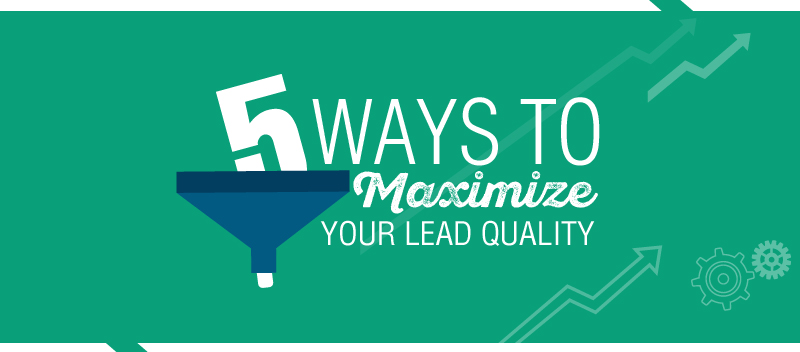No matter your industry, you know that not all leads are created equal, which means generating leads isn’t enough; you need to generate quality leads so as not to waste time and money. How big a deal is lead quality? A 10% increase in lead quality can create a 40% jump in revenue, according to Marketo.
What is Lead Quality?
Lead quality is a measurement of how likely a given lead is to convert to a paying customer or how much revenue potential that a given lead could generate for your company. Since a lead is essentially just information you’ve attained on someone who is interested in your product or service, it makes sense from a business perspective to rank all those leads.
By measuring lead quality, sales teams can focus on specific leads instead of inefficiently allocating resources attempting to convert low-quality leads who have little interest in becoming paying customers, or who present little potential for revenue. According to Salesforce, companies that have a method for scoring leads have an ROI of 138% versus companies without any lead scoring criteria.
Related: Classification of Sales Leads: Hot, Warm or Cold
Each company takes its own approach to measuring lead quality. However, a common method is to assign a score to leads based on certain criteria, such as the B.A.N.T criteria (budget, authority, need, timetable). However, B.A.N.T is mostly used within B2B marketing, and even there, debate rages about its ongoing relevance. B.A.N.T assumes telephone contact with leads, which is not a valid assumption in a marketing world dominated by online marketing.
Other possible lead scoring criteria include:
- People who have downloaded lead magnets from your website
- Leads who have browsed through product pages, checkout carts, or pricing pages
- People who have emailed or phoned your sales teams to inquire about your products/services
- The revenue potential of a given lead
Companies can segment their leads based on a set of lead scoring criteria by integrating marketing software with customer relationship management (CRM) systems.
Related: Not Just an Address Book: 4 Hacks to Turn a CRM into a True Sales Tool
It’s important to note that not all leads with high likelihoods of conversion are high-quality leads by default—leads might be very likely to convert but present poor earning potential. This is one of the biggest issues with the idea of lead quality—different people have different definitions of what exactly constitutes quality. It can be helpful, therefore, for marketing and sales personnel to work together to develop sensible lead scoring criteria that they agree on.
A high volume of bad leads is the fastest way to clog up your sales funnel. If you’re casting too wide of a net, it’s time to re-evaluate how and where you’re getting leads, what constitutes a good lead, and why some leads go cold so fast. Here are a few tools to help you maximize and improve your lead quality.
#1 Define what a qualified lead is

Who determines what’s a good lead in your company? If you don’t know, or if you think it’s the wrong person, it might be time for everyone involved in the sales process to sit down to define a qualified lead for your business.
Is it simply someone who falls within your target market? Is it based on behavior when visiting your website? Maybe it’s someone that agrees to hear your pitch in person.
If your sales team is expected to follow up immediately on every nibble, you’re taking time away from the qualified leads so it’s important to define what a qualified lead is.
#2 Identify where leads come from

Where do you get your best leads from? Identify your lead sources so you can fine-tune your lead generation process.
Consider using a tool like Google Analytics or Oktopost to look at your metrics and determine where your quality leads come from and what campaigns, referrers, and channels are paying for themselves.
Knowing the information, you can devote more time to channels that are most effective and may even consider eliminating channels that aren’t filling your lead pipeline.
Related: The Five BEST Sources Of B2B Leads Prospects
Check out our latest Marketing Infographic
#3 Deploy data enrichment tools

To connect with prospective customers, you need to a way to reach them. You can search LinkedIn, run Google searches, and scour social media channels for leads, but it takes a lot of time to find the right people, and then, find their contact information.
Related: Why Customer Profiling Could be the Best Investment your Company Makes
Ease some of this workload with data enrichment tools that can help you build a list of leads along with credible contact information. Here are a few tools to consider:
Turn domain names into full company profiles and add contact information right into your Salesforce account to convert leads faster. Lusha can even automatically enrich all your contacts and update your contacts in spreadsheets.
Increase your volume of clean, actionable leads thanks to the missing data that InsideView automatically adds to incoming leads as they’re inputted into your CRM and marketing automation systems.
Streamline your sales funnel by connecting your third-party apps to pull together data, then create your own set of rules to clean the database with Openprise.
Related: The Essential Checklist to Finding a Decent Leads Database Provider
#4 Use lead generation tools

Rather than find leads yourself, have them come to you. How? Use a few lead generating tools, like these:
PromoSimple
Create custom sweepstakes, sign-up forms, and contests that can be added to Facebook pages and websites to generate leads, which are then integrated into an email service provider.
SocialCompass
Find quality leads on Twitter with this all-in-one app that combs tweets to find locals with purchase intent, allowing you to reply with an offer.
Related: Best Marketing Tools to INCREASE Sales Leads Production
#5 Prioritize your leads with management applications

As you generate leads, you’ll need a way to manage them. Try these tools that can help you prioritize leads and track important metrics like cost per lead:
Velocify
Help your sales reps determine who to call and when, thanks to this sales acceleration solution that sorts, prioritizes, and re-ranks sales leads in real-time.
Really Simple Systems
Track cost per lead, per opportunity, and per sale to calculate your ROI with this lead tracking app.
Related: 5 New Year’s Resolutions to Refine Your Marketing Analytics Stack
Wrap up
By identifying what a qualified lead is, making a list of your best lead channels, and integrating several tools, you’ll be able to reach more prospects than you thought possible. Lead generation is a time-consuming process, but if you’re taking a strategic approach you’ll likely see an impressive return on your investment.











